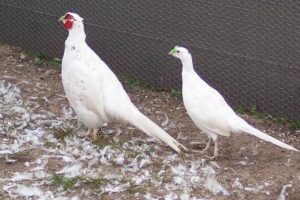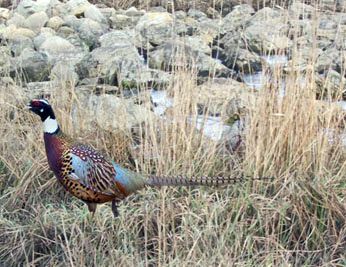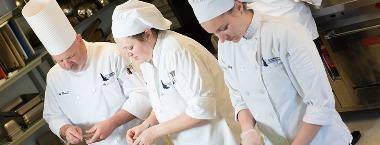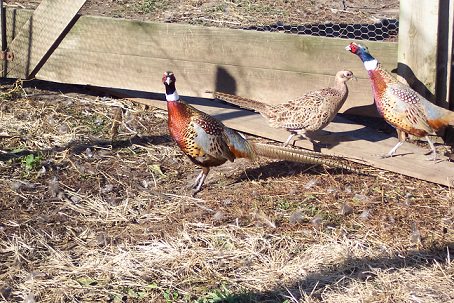The Journey of MacFarlane’s White Pheasants
When I was growing up, my family lived on MacFarlane Pheasant Farm. We had a 3-foot high sign that said “Oven Ready Pheasants” by the road. We had a big freezer in our garage, and people would stop at any time of the day to buy dressed birds from us. We would sell about 3,000 birds each year through these drop-ins.
The Decision to Grow Our White Bird Business
It was a great way to add extra income to our gamebird business. In 1979, when I moved back home to take over the management of the farm, the farm was still selling about 3,000 dressed birds annually. It was clear to me that the market was changing, and we needed to adapt to continue thriving and this was an area I thought we could grow in.
At the time, we also raised and sold Jumbo Ringneck pheasant chicks, which many of our customers would buy to raise for their own dressed bird sales. I knew that these would be great birds for us to start processing more regularly.
In 1988 a friend of mine, Brian Reff, who lived in California, suggested that we take our dressed bird business more seriously. I felt confident in the decision after his support, and we began processing birds at a nearby plant once a week, starting a new chapter for MacFarlane Pheasants.
Continual Genetic Improvement
 In the 1970s, my father, Donald MacFarlane, was contacted by a professor at Texas A&M, Dr. Richard Cain, who wanted to develop a new breed of meat pheasants. My father shipped some of our white pheasants and Jumbo Ringneck pheasants to Texas, where they became part of a research program to create a bird that grew quickly and efficiently—ideal for meat production.
In the 1970s, my father, Donald MacFarlane, was contacted by a professor at Texas A&M, Dr. Richard Cain, who wanted to develop a new breed of meat pheasants. My father shipped some of our white pheasants and Jumbo Ringneck pheasants to Texas, where they became part of a research program to create a bird that grew quickly and efficiently—ideal for meat production.
By the mid-1980s, the research program was winding down, and I received a call from Texas A&M. They were disbanding the project and asked if we wanted the remaining birds. Without hesitation, I brought them back to our farm, not knowing what we would receive. These white birds, which grew fast and required less feed than other types, became the foundation of our meat pheasant operation.
These birds were quite different from the wild pheasants we traditionally raised. They had unique dietary needs, distinct growth patterns, and required specialized care. Initially, the cocks reached about 4 pounds in 20 weeks, while the hens reached 3 pounds in 24 weeks. Although impressive, we believed we could improve further.
Dr. Nick Anthony, a geneticist, began visiting us twice a year to help select the best birds for breeding. Through careful banding and selection, we reduced the time it took for our cocks to reach maturity to just 14 weeks by 2010. By 2017, we had further shortened that period to only 12 weeks. This efficiency level has allowed us to produce more birds faster without compromising quality.
MacFarlane’s White Bird Business Growth
 By 1998, we were selling 200,000 dressed pheasants each year. These birds had become one of the key aspects of our operations, and I’m incredibly proud of what we achieved.
By 1998, we were selling 200,000 dressed pheasants each year. These birds had become one of the key aspects of our operations, and I’m incredibly proud of what we achieved.
In 2019, we decided to expand into the pet industry by launching a new brand called Pure Pheasant. By leveraging our white birds, we’ve developed a line of products that included a raw prey diet, pheasant feet, pheasant heads, and more. This move not only aligned with our commitment to sustainability but also tapped into the growing demand for high-quality, natural pet treats. Pure Pheasant allowed us to utilize more of the birds and reduce waste while providing pets with nutritious, premium products.
Looking Toward the Future
Like many businesses, we were hit hard by COVID-19. The pandemic brought challenges we could never have anticipated. Demand fluctuated, and we struggled to maintain efficiency in a rapidly changing market. However, as with all challenges, it also brought new opportunities.
One of our dedicated employees of seven years, Ronnie Viljoen, expressed interest in taking over the ownership and management of the white bird operation. After careful consideration, we decided this was the right move for both Ronnie and MacFarlane Pheasants. As of August 15th, Ronnie and his team at Midwest Pheasant LLC have purchased the white bird operation, continuing to use the same genetics and birds we’ve developed over the years.
We are confident that Midwest Pheasant LLC will uphold the high standards we’ve set, and we’re excited to see where they take the business.
We’ve come a long way from the days of selling “Oven Ready Pheasants” out of our garage. Our farm has grown, adapted, and thrived in ways I could never have imagined when I first took over. As we look to the future, we are excited for the next chapter in our story. MacFarlane Pheasants will continue to grow and evolve.
Thank you for being a part of our journey.
– Bill MacFarlane
Any inquiries regarding the future of our white birds please contact Savannah at s.viljoen@midwestpheasant.com.
Related Posts

Important Announcement: Transition of MacFarlane Pheasants’ White Bird Division
Read Post

A Simple Pheasant Feast for Guests
Read Post

Back to the Past – Manchurian Project – Part 2
Read Post

Celebrating Bill MacFarlane!
Read Post

Celebrating Blackhawk Technical College Culinary Program and Chef Joe Wollinger
Read Post

Chef Alfonso Contrisciani and his Assistant Otto Borsich Prepared MacFarlane Pheasant at the 2023 NAGA convention
Read Post

Chunky Pheasant and Bean Soup Is the Perfect Meal for A Snowy Day!
Read Post

Coming to America: The Pheasant’s History in the United States
Read Post
Take Advantage of These Free Resources
As the biggest game bird farm in the United States, we want to share our experience with you. Download our free resources below and get started.





